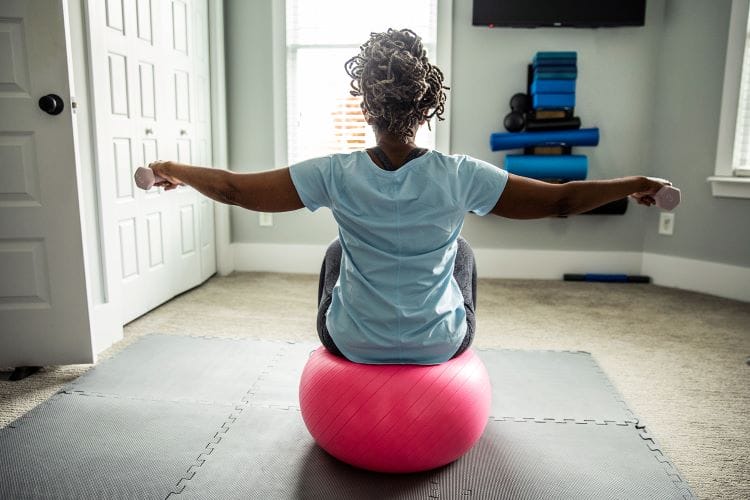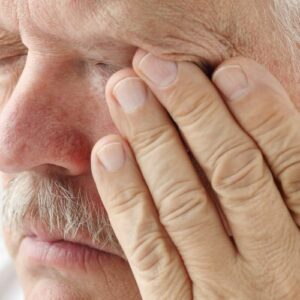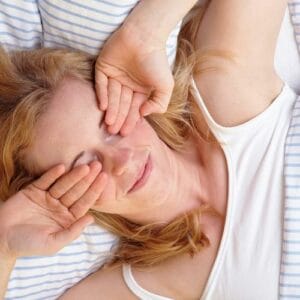February 23, 2024
It has been well established that as we age, the risk of dry eye disease increases. Although we can’t alter the inevitability of aging, there are modifiable risk factors within our control, and sometimes our own behaviors unknowingly contribute to worsening dry eye symptoms. Exercise, skin care, and sleep habits all contribute to the incidence of dry eye in aging patients. Here’s how.
How Exercise Impacts Dry Eye Symptoms
It is no secret that a sedentary lifestyle can contribute to a plethora of health risks such as obesity, cardiovascular disease, and diabetes. But can a sedentary lifestyle impact our dry eye patients as well?
A literature review published in Contact Lens and Anterior Eye examined 16 papers that found a potential role for physical activity as a modulatory stimulus for the proper functioning of the tear film and/or the relief of dry eye symptoms.1 Another study showed that a 10-week exercise program improved subjective dry eye symptoms of healthy office workers.2
Physical inactivity describes people who do not get the recommended level of consistent physical exercise. The American Heart Association recommends aerobic exercise for 30 to 60 minutes three to four times per week. In our modern society, physical inactivity is an epidemic.
In the majority of countries, the average body mass index has increased over the past few decades, which has led to a higher prevalence of medical conditions, including obesity, hypertension, diabetes, and obstructive sleep apnea, among others.3
There are varied reports on the relationship between obesity and dry eye disease, however dry eye disease, meibomian gland dysfunction, and floppy eyelids have also been associated with obstructive sleep apnea, a comorbid disease with obesity.4
How does exercise improve dry eye symptoms? The current theory suggests that as exercise intensity escalates, there is an initial sharp decline in parasympathetic activity, followed by a gradual increase in sympathetic nervous system activation. Of note, the acinar cells of the lacrimal gland possess cholinergic and adrenergic receptors. These receptors appear to independently stimulate lacrimal gland blood flow as well as the secretion of proteins, water, and electrolytes.5 As a result, the simultaneous action of both autonomic divisions on the lacrimal gland might influence tear volume and/or alterations in its composition following exercise.
Beware of Harmful Skin Care Practices
While skin care routines are often touted as essential for maintaining youthful skin, certain products and procedures may inadvertently harm ocular health, particularly in individuals prone to dry eye syndrome. Eye creams containing retinoids, commonly used for their anti-aging properties, can cause irritation and exacerbate dry eyes.
Cosmetic ingredients have multiple purposes in makeup. They serve as an abrasive, absorbent, antimicrobial, antioxidant, buffer, colorant, emollient, emulsifier, pH adjuster, as well as anticaking and antifoaming to name a few.6 The ingredients provide these functions in a myriad of eye makeup products, including creams around the eye, eyeliners, eyeshadows, eyelash glues, makeup primers, makeup removers, mascaras, moisturizers, serums, and/or wet wipes.
The “TFOS Lifestyle: Impact of cosmetics on the ocular surface” report includes tables that list evidence-based concerns about various ingredients in ocular cosmetics including preservatives to avoid.7 The TFOS Lifestyle report is an excellent resource for additional information on how to modify our behaviors to prevent worsening dry eye symptoms.
One common “anti-aging” ingredient found in skin care products is retinoic acid. This has been found in both animal and human studies to have a direct effect in inhibiting meibomian gland cell proliferation, inducing cell death, and altering the expression of thousands of genes, including those for keratinization and inflammation.8 The systemic use of retinoic acid decreases meibomian gland function, causing atrophy of the acini and hyposecretion of oil, affecting tear osmolarity and evaporation, leading to significant dry eye symptoms.9
Additionally, botulinum toxin is a common cosmetic treatment that is injected into the orbicularis oculi muscle to treat a patient’s “crows feet.” However, this can result in blink dysfunction, lagophthalmos, and in more severe cases, ectropion, giving rise to symptoms of eye irritation, foreign body sensation, and epiphora.10
Careful questioning on the use of botulinum toxin (common names are Botox/Dysport/Xeomin), close observation of a patient’s blinking patterns, and performing the snap-back test can help guide a clinician to a potential etiology of your patient’s dry eye symptoms.
The snap-back test involves gently pulling the lower lid downward while the patient maintains primary gaze without blinking. Upon release, if the lower lid doesn’t recoil before the next blink, the snap-back test is positive and is documented in seconds.
Why Sleep Habits Matter
Sleep quantity and quality can also affect a patient’s dry eye outcome, as we have covered before in this Dry Eye section of Review of Presbyopia and the Aging Eye. In a meta-analysis and systematic review of 19 articles, individuals with dry eye disease exhibit worse sleep quality when compared with controls.11 Further, they tend to spend a smaller amount of time asleep, have more frequent sleep disturbances, and can have increased incidence, prevalence, and severity of sleep disorders.11
Thankfully, exercise, another beneficial activity for dry eyes, can also improve sleep. Additionally, keeping a consistent nighttime routine, removing devices from the bedroom, and avoiding large meals and caffeine can help improve sleep quality.12
Although we can’t change getting older, we can modify factors to manage dry eye disease with time.
References
1 Sergio Navarro-Lopez, et.al. Effects of physical activity/exercise on tear film characteristics and dry eye associated symptoms: A literature review . Contactlens & Anterior Eye. 2023, Volume 46, Article ID 101854.
2 Kokoro Sano, et. al.. Exercise program improved subjective dry eye symptoms for office workers. Clin Ophthalmol. 2018; 12: 307–311.
3 Yadav HM, Jawahar A. Environmental factors and obesity. StatPearls. Treasure Island (FL; 2022.
4 Galor A, Britten-Jones AC, Feng Y, Ferrari G, Goldblum D, Gupta PK, Merayo-Lloves J, Na KS, Naroo SA, Nichols KK, Rocha EM, Tong L, Wang MTM, Craig JP. TFOS Lifestyle: Impact of lifestyle challenges on the ocular surface. Ocul Surf. 2023 Apr;28:262-303. doi: 10.1016/j.jtos.2023.04.008. Epub 2023 Apr 11. Erratum in: Ocul Surf. 2024 Jan 25;32:104. PMID: 37054911.
5 Dartt DA. Neural regulation of lacrimal gland secretory processes: relevance in dry eye diseases. Prog Retin Eye Res 2009;28(3):155–77.
6 Belmonte C, Nichols JJ, Cox SM, Brock JA, Begley CG, Bereiter DA, et al. TFOS DEWS II pain and sensation report. Ocul Surf 2017;15(3):404–37.
7 Sullivan DA, da Costa AX, Del Duca E, Doll T, Grupcheva CN, Lazreg S, Liu SH, McGee SR, Murthy R, Narang P, Ng A, Nistico S, O’Dell L, Roos J, Shen J, Markoulli M. TFOS Lifestyle: Impact of cosmetics on the ocular surface. Ocul Surf. 2023 Jul;29:77-130. doi: 10.1016/j.jtos.2023.04.005. Epub 2023 Apr 13. PMID: 37061220.
8 Chameen Samarawickrama, et.al. Retinoic acid and the ocular surface. Surv Ophthalmol, 2015 May-Jun;60(3):183-95.
9 Bozkurt B, Irkec MT, Atakan N, et al. Lacrimal function and ocular complications in patients treated with systemic isotretinoin. Eur J Ophthalmol. 2002;12:173e6
10 Omar Ozgur, et.al, Dry Eye Syndrome Due to Botulinum Toxin Type-A Injection: Guideline for Prevention, Hawaii J Med Public Health. 2012 May; 71(5): 120–123.
11 Merikanto I, Kortesoja L, Benedict C, Chung F, Cedernaes J, Espie CA, et al. Evening-types show highest increase of sleep and mental health problems during the COVID-19 pandemic – multinational study on 19,267 adults. Sleep; 2021.
12 Tips for Better Sleep. Centers for Disease Control and Prevention





